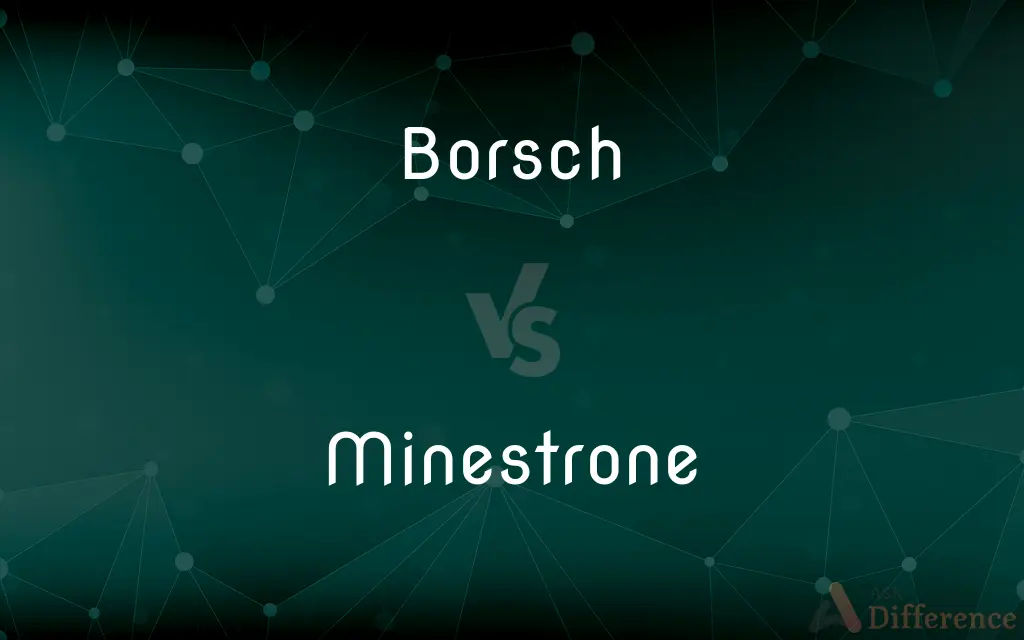Borsch vs. Minestrone — What's the Difference?
By Urooj Arif & Fiza Rafique — Updated on March 19, 2024
Borsch is a beet-based soup from Eastern Europe with a distinct reddish-purple color, while Minestrone is a hearty Italian soup made with vegetables, beans, and pasta.

Difference Between Borsch and Minestrone
Table of Contents
ADVERTISEMENT
Key Differences
Borsch, originating from Eastern Europe, is traditionally made with beets, giving it a unique reddish-purple color and slightly sweet flavor. It often includes meat and is served with a dollop of sour cream. Whereas Minestrone, hailing from Italy, is a thick soup made from a variety of vegetables, beans, and pasta or rice. It's known for its robust flavor and is often vegetarian.
Borsch is typically associated with Ukrainian and Russian cuisine and is considered a comfort food during cold weather. It can be served hot or cold. On the other hand, Minestrone is a staple in Italian cuisine, embodying the use of seasonal, fresh vegetables, making it a versatile dish that varies by region.
The key ingredient in Borsch is beets, which not only provide its distinctive color but also contribute to its earthy sweetness. Meanwhile, Minestrone does not rely on a single vegetable for its base; it is a mix of whatever vegetables are in season, often including tomatoes, which lend a slight acidity to the soup.
Borsch's flavor profile is often enhanced with the addition of dill, garlic, and sometimes vinegar, giving it a unique, tangy taste. Conversely, Minestrone is seasoned with a variety of Italian herbs such as oregano, basil, and thyme, which offer a Mediterranean aroma and flavor.
Despite their differences, both soups are known for being hearty and filling. Borsch may contain chunks of beef or pork, while Minestrone is typically packed with beans and pasta, providing protein and substance to the meal.
ADVERTISEMENT
Comparison Chart
Origin
Eastern Europe (e.g., Ukraine, Russia)
Italy
Base Ingredient
Beets
A variety of vegetables
Common Ingredients
Beets, cabbage, potatoes, meat, sour cream
Beans, pasta or rice, tomatoes, onions, carrots, celery
Flavor
Sweet, earthy, sometimes tangy due to vinegar or lemon
Savory, herbaceous, vegetable-rich
Serving Temperature
Typically served hot, but can be served cold
Usually served hot
Color
Reddish-purple
Varies, often reddish due to tomatoes
Vegetarian Option
Often contains meat, but can be made vegetarian
Often vegetarian, but can be adapted
Compare with Definitions
Borsch
A traditional Eastern European soup primarily made from beets, giving it a distinct reddish-purple color.
For dinner, we enjoyed a warm bowl of Borsch, its vibrant color brightening the table.
Minestrone
Minestrone represents the Italian knack for creating rich flavors from simple ingredients.
The Minestrone served at the trattoria was a testament to the rustic, yet refined, Italian culinary tradition.
Borsch
Borsch can include various vegetables and meat, often garnished with sour cream.
Our version of Borsch today features tender beef and a heap of fresh dill.
Minestrone
A thick Italian soup made with vegetables, beans, and pasta or rice.
Tonight's Minestrone was brimming with garden-fresh vegetables and aromatic herbs.
Borsch
In many Eastern European countries, Borsch is more than just a soup; it's a cultural symbol.
At the festival, Borsch was served as a homage to traditional Eastern European cuisine.
Minestrone
Minestrone is often vegetarian, making it a staple in many diets.
Our vegetarian Minestrone is hearty and satisfying, even for the meat-lovers at the table.
Borsch
Beets, the main ingredient, are known for their health benefits, including fiber, vitamins, and minerals.
Borsch not only tantalizes the taste buds but also offers a nutritious boost thanks to its beet base.
Minestrone
Known for its hearty nature, Minestrone is considered comfort food for many.
On a chilly evening, a bowl of steaming Minestrone can warm the soul and lift the spirits.
Borsch
It can be served hot or cold, making it versatile for different seasons.
Despite the summer heat, the chilled Borsch was a refreshing meal.
Minestrone
The ingredients in Minestrone vary by season and region, reflecting the local produce available.
This Minestrone features zucchini and white beans, showcasing the summer harvest.
Borsch
A beet soup served hot or cold, usually with sour cream.
Minestrone
Minestrone (; Italian: [mineˈstroːne]) is a thick soup of Italian origin made with vegetables, often with the addition of pasta or rice, sometimes both. Common ingredients include beans, onions, celery, carrots, leaf vegetables, stock, parmesan cheese and tomatoes.
Borsch
Alternative spelling of borscht
Minestrone
A thick soup of Italian origin containing assorted vegetables, beans, pasta such as vermicelli or macaroni, and herbs in a meat or vegetable broth.
Borsch
A Russian soup usually containing beet juice as a foundation
Minestrone
Any of many thick Italian vegetable soups.
Minestrone
Soup made with a variety of vegetables
Common Curiosities
Is Borsch always served with sour cream?
While sour cream is a traditional garnish for Borsch, it's not mandatory and can be omitted based on dietary preferences.
Can Minestrone be made without pasta?
Yes, Minestrone can be made without pasta, substituting it with rice or simply focusing on the beans and vegetables.
What makes Borsch unique?
Borsch is unique due to its primary use of beets, which impart a distinctive reddish-purple color and slightly sweet taste to the soup.
How do the flavors of Borsch and Minestrone differ?
Borsch tends to have a sweeter, earthier flavor due to the beets, while Minestrone has a savory, herbaceous flavor from the variety of vegetables and herbs used.
How can the thickness of Minestrone be adjusted?
The thickness of Minestrone can be adjusted by varying the amount of broth, vegetables, and beans or pasta used in the recipe.
Can Borsch be made vegetarian?
Yes, Borsch can be made vegetarian by omitting the meat and using vegetable broth instead of meat broth.
Is Minestrone considered a healthy soup?
Minestrone is considered healthy due to its high content of vegetables, fiber from beans, and whole grains from pasta or rice.
Can Borsch be served cold?
Yes, Borsch can be served cold, especially in warmer climates or seasons, offering a refreshing soup option.
What are common vegetables found in Minestrone?
Common vegetables in Minestrone include carrots, celery, tomatoes, onions, and sometimes zucchini or green beans.
What protein sources can be added to Minestrone?
Beyond beans, Minestrone can include meats like pancetta or sausage, or it can be kept vegetarian with the addition of tofu or extra beans for protein.
What is the origin of Borsch?
Borsch is believed to have originated in Ukraine but has become a staple in various Eastern European cuisines.
Does the recipe for Minestrone vary by region in Italy?
Yes, Minestrone recipes can vary significantly by region in Italy, reflecting the local produce and culinary traditions.
What makes Minestrone a popular choice in vegetarian cuisine?
Minestrone's popularity in vegetarian cuisine comes from its use of diverse vegetables and beans, making it a hearty and nutritious option.
Are there different versions of Borsch depending on the country?
Yes, there are variations of Borsch in different countries, with some versions including ingredients like fish or mushroom.
Is there a specific type of beet that should be used for Borsch?
Any type of red beet can be used for Borsch, though some prefer specific varieties for their sweetness and color.
Share Your Discovery

Previous Comparison
Legend vs. Mythology
Next Comparison
Courteous vs. ConsiderateAuthor Spotlight
Written by
Urooj ArifUrooj is a skilled content writer at Ask Difference, known for her exceptional ability to simplify complex topics into engaging and informative content. With a passion for research and a flair for clear, concise writing, she consistently delivers articles that resonate with our diverse audience.
Co-written by
Fiza RafiqueFiza Rafique is a skilled content writer at AskDifference.com, where she meticulously refines and enhances written pieces. Drawing from her vast editorial expertise, Fiza ensures clarity, accuracy, and precision in every article. Passionate about language, she continually seeks to elevate the quality of content for readers worldwide.
















































